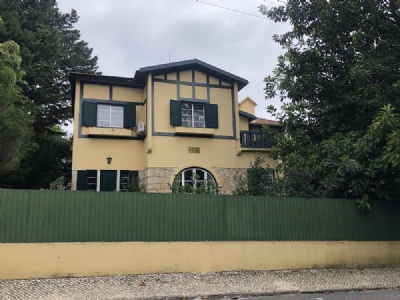Estoril – Horthy villa
About ten kilometres west of Lisbon in the fashionable Estoril, the Hungarian former regent Miklos Horthy lived in a nice villa between 1950 til his death in 1957. Horthy had served in the austro-hungarian fleet during First World War. After the war he became politically engaged and in 1920 was appointed Hungarian head of state. In 1920, and as the first country in Europe, anti-Semitic laws were introduced making studies at hungarian universities difficult for Jews.
Hungary’s form of government was nationalistic with a large element of conservatism and therefore fitted well into the wave of nationalist parties and currents that swept over Europe during the thirties. Hungary therefore came to ally itself with Germany and Italy in 1938 and introduced additional anti-Semitic laws. But when the Holocaust radicalized in 1941 and 1942, Hungary did not follow Germany’s radicalization towards the Jews. The Jews could therefore, albeit with elements of anti-Semitism, stay in Hungary without being deported to Nazi controlled areas.
When Germany invaded Soviet Union, June 22, 1941, Hungary declared Soviet Union war a few days later. Under german pressure, they sent troops to Soviet Union put under german command, but kept the majority of its troops in Hungary. When the tide of war turned in 1943, Horthy tried to find a way out of the alliance with Hitler. This was something Hitler couldn’t accept and occupied Hungary in mid-March 1944 and installed a pro-nazi government. This was followed by an escalation of the persecution of the Jews and about 400,000 Jews were deported from Hungary to Auschwitz between March and July 1944.
Horthy reluctantly had to accept this for the time being. But when western countries put pressure on him and threatened to hold him accountable Horthy stopped the deportations in August 1944. He installed a new prime minister who resumed diplomacy and withdraw Hungary from the war. Hitler was furious and imprisoned Horthy and took his son hostage just to make sure he didn’t do any more harm to german interests. A new German-friendly government, the Arrow Cross Party, led by Ferenc Szalazi, took power and remained until the end of the war. During this time Jewish persecutions escalated.
After the war, Horthy was imprisoned for a short time but was released in December 1945 and reunited with his family. He also testified in the Nuremberg trials. But he could not return to Hungary because the country had become a Communist state. The family therefore continued to live in Bavaria, Germany, until 1950 when they moved to a nice villa in Estoril outside Lisbon. When Horthy died in 1957, he was buried in Lisbon. But in 1993, after Hungary freed itself from communism, he was, as he wished, reburied in Hungary.
Current status: Preserved with tablet (2023).
Address: 1937 R. Dom Afonso Henriques, 2765-573 Estoril.
Get there: Walk.
Follow up in books: Levine Paul A: Raoul Wallenberg in Budapest: Myth, History and Holocaust (2010).



There is a small information board on the facade facing the street. Until a few years ago a Guest House was run in the villa but it seems now closed. The villa is also surrounded by a high fence that obstructs insight and the impression is that those who lives there, or own the villa, seems shady.